Optimizing Efficiency of Tea Harvester Leaf-Collection Pipeline: Numerical Simulation and Experimental Validation
Abstract
:1. Introduction
2. Materials and Methods
2.1. Overall Structure and Working Principle of Tea Harvester
2.2. Boundary Conditions and Solution Parameter Settings
2.3. Determination of Factors Affecting the Structure of the Leaf-Collecting Pipeline
2.3.1. External Structural Design
- (1)
- Main pipe taper
- (2)
- Number of branches pipes
- (3)
- Inner diameter of branch pipe outlet
2.3.2. Internal Structural Design
2.3.3. Test Indicators
3. Results and Analysis
3.1. External Structural Parameters
3.1.1. Single-Factor Test
- (1)
- Effect of main pipe taper on each indicator
- (2)
- Effect of number of branch pipes on each indicator
- (3)
- Effect of inner diameter of branch pipe outlet on each indicator
3.1.2. Experimental Scheme and Results
3.1.3. Effect of Interactions on Average Outlet Wind Speeds
3.1.4. Effect of Interactions on Wind Speed Non-Uniformity
3.1.5. Parameter Optimization
3.2. Optimization of the Internal Structure of the Leaf-Collecting Pipe
3.3. Field Experiment
4. Conclusions
- (1)
- An orthogonal test was used to analyze the results using the average outlet wind speed and wind speed non-uniformity as the test indicators. The optimal parameter combination was determined to be a main pipe taper of 25.5 mm, 10 branch pipes, and an inner diameter of the branch pipe outlet at 17.10 mm. Under these conditions, the average outlet wind speed measured 10.73 m/s, with wind speed non-uniformity at 8.24%.
- (2)
- Comparison experiments conducted before and after optimization revealed a reduction in the maximum speed deviation ratio of branch pipe wind speed by 12.04% and a decrease in wind speed non-uniformity by 4.53%. Validation experiments were carried out using the optimal parameters, demonstrating an average outlet wind speed of 10.80 m/s and wind speed non-uniformity of 8.21%, thereby confirming the reliability of the simulation results.
- (3)
- To enhance the uniformity of wind speed at the outlet of the leaf-collecting pipeline, a comparison was made between gas velocity and pressure variations in each section of the internal structural branch of the leaf-collecting pipeline. The results indicated that at an average outlet wind speed of 11.02 m/s and wind speed non-uniformity of 8.04%, the experimental indicators of the internal structure of the leaf-collecting pipeline, outperformed those of the external structure with an error rate below 5%. Field experiments demonstrated a stalk leakage rate of 3.40%, a bud and leaf integrity rate of 90.36%, and that the optimization of the leaf-collecting pipeline structure not only improved the uniformity of airflow distribution but also effectively enhanced picking efficiency. This study provides a robust theoretical foundation for optimizing the design of the leaf-collecting pipeline structure.
Author Contributions
Funding
Institutional Review Board Statement
Data Availability Statement
Conflicts of Interest
References
- Chen, Y.T.; Chen, S.F. Localizing plucking points of tea leaves using deep convolutional neural networks. Comput. Electron. Agric. 2020, 171, 105298. [Google Scholar] [CrossRef]
- Jia, J.; Ye, Y.; Cheng, P.; Zhu, Y.P. Design and experimental optimization of hand held manipulator for picking famous tea shoot. Trans. Chin. Soc. Agric. Mach. 2022, 53, 86–92. [Google Scholar] [CrossRef]
- Han, Y.; Xiao, R.; Song, Y. Design and evaluation of tea-plucking machine for improving quality of tea. Appl. Eng. Agric. 2019, 35, 979–986. [Google Scholar] [CrossRef]
- Li, X.; Lin, Y.; Zhao, S. Transcriptome changes and its effect on physiological and metabolic processes in tea plant during mechanical damage. For. Pathol. 2018, 48, e12432. [Google Scholar] [CrossRef]
- Ashfaq, S.; Ahmad, M.; Munir, A.; Ghafoor, A. Improvement of air homogeneity in paddy dryer with central air flow channel. Int. J. Food Eng. 2017, 13, 20150408. [Google Scholar] [CrossRef]
- Daza, G.; Pereyra, E.; Ratkovich, N. CFD simulation of two phase gas/non-Newtonian shear thinning fluid flow in pipes. Braz. Soc. Mech. Sci. 2019, 41, 506. [Google Scholar] [CrossRef]
- Weng, X.; Chen, C.; Wang, G.; Wei, Z. Numerical Simulation of leaf gathering process of fresh leaf collecting pipeline based on CFD-DEM. Trans. Chin. Soc. Agric. Mach. 2022, 53, 424–432. [Google Scholar] [CrossRef]
- Lei, X.; Liao, Y.; Zhang, W.; Li, S.; Shanshan, W. Simulation and experiment of gas solid flow in seed conveying tube for rapeseed and wheat. Trans. Chin. Soc. Agric. Mach. 2017, 48, 57–68. [Google Scholar] [CrossRef]
- Chen, S.; Xiao, J.; Rao, S.; Wu, M. CFD numerical analysis of airflow blowing velocity field of medicago hispida harvester. Trans. Chin. Soc. Agric. Eng. 2016, 32, 39–46. [Google Scholar] [CrossRef]
- Li, Y.; Yi, Y.; Du, S.; Ding, Q. Design and experiment on air blowing header of plot combine harvester for grain. Trans. Chin. Soc. Agric. Mach. 2017, 48, 79–87. [Google Scholar] [CrossRef]
- Weng, X.; Tan, D.; Wang, G.; Chen, C.; Zheng, L. CFD Simulation and optimization of the leaf collecting mechanism for the riding type tea plucking machine. Agriculture 2023, 13, 946. [Google Scholar] [CrossRef]
- Liu, R.; Liu, L.; Li, Y.; Liu, Z.; Zhao, J. Numerical simulation of seed movement characteristics in new maize delivery device. Agriculture 2022, 12, 1944. [Google Scholar] [CrossRef]
- Li, Y.; Liu, R.; Liu, C. Simulation and test of seed velocity coupling in seed tube of pneumutic seed metering device. Trans. Chin. Soc. Agric. Mach. 2021, 52, 54–61. [Google Scholar] [CrossRef]
- Endalew, A.M.; Debaer, C.; Rutten, N.; Vercammen, J.; Delele, M.A.; Ramon, H.; Nicolaï, B.M.; Verboven, P. A new integrated CFD modelling approach towards air assisted orchard spraying—Part II: Validation for different sprayer types. Comput. Electron. Agric. 2010, 71, 137–147. [Google Scholar] [CrossRef]
- Endalew, A.M.; Debaer, C.; Rutten, N.; Vercammen, J.; Delele, M.A.; Ramon, H.; Nicolaï, B.M.; Verboven, P. A new integrated CFD modelling approach towards air assisted orchard spraying. Part I. Model development and effect of wind speed and direction on sprayer airflow. Comput. Electron. Agric. 2010, 71, 128–136. [Google Scholar] [CrossRef]
- Wu, B.; Huang, K.; Qing, D.; Zhu, M. Numerical simulation and optimization of perforated tube trolley in circular cooler. World J. Eng. Technol. 2017, 5, 684–695. [Google Scholar] [CrossRef]
- Hong, S.; Zhao, L.; Zhu, H. CFD simulation of airflow inside tree canopies discharged from air-assisted sprayers. Comput. Electron. Agric. 2018, 149, 121–132. [Google Scholar] [CrossRef]
- Lu, Y.; Hu, Z.; Lin, D. Numerical simulation of peanuts particles conveying in pipeline using CFD-DEM coupled approach. Trans. Chin. Soc. Agric. Eng. 2016, 37, 104–109. [Google Scholar] [CrossRef]
- Shi, J.; Wu, Z.; Liu, Q.; Lou, Z.; Zhao, Y. CFD simulation and optimization of airflow field in industrial tunnel dryer with different blowing designs. Trans. Chin. Soc. Agric. Eng. 2014, 30, 315–321. [Google Scholar] [CrossRef]
- Ou, M.; Gao, T.; Wu, M.; Dong, X.; Jia, W. Simulation and experimental study of multi-duct air assisted orchard spray system based on CFD. Trans. Chin. Soc. Agric. Eng. 2021, 11, 70–75. [Google Scholar] [CrossRef]
- Zhong, H.; Mujumdar, A. CFD modeling of the gas particle flow behavior in spouted beds. Powder Technol. 2008, 183, 260–272. [Google Scholar] [CrossRef]
- Wang, L.; Huang, H.; Yi, Y. Optimization design and test of air flow pipe structure in small scale rape combined harvester. Chin. J. Agric. Mech. Eng. 2020, 41, 16–24. [Google Scholar] [CrossRef]
- Ou, A.; Shao, F.; Shu, S. Structural design of a monorail suspended tea picker and its simulation analysis of ventilation tube flow field. J. Agric. Sci. 2019, 47, 236–240. [Google Scholar] [CrossRef]
- Qin, W.; Wang, Z.; Wang, Y. Analysis and experiments of the air pressure loss in multi-branch convergence pipe of air suction seeder. Trans. Chin. Soc. Agric. Eng. 2023, 39, 111–127. [Google Scholar] [CrossRef]
- Zhu, Q.; Zhang, H.; Zhu, Z.; Gao, Y.; Chen, L. Structural Design and simulation of pneumatic conveying line for a paddy side deep fertilisation system. Agriculture 2022, 12, 867. [Google Scholar] [CrossRef]
- Han, W.; Wu, P.; Yang, Q.; Feng, H. Advances and comparisons of uniformity evaluation index of sprinkle irrigation. Trans. Chin. Soc. Agric. Eng. 2005, 21, 172–177. [Google Scholar] [CrossRef]
- Xia, J.; Lin, S.; Wang, F.; Wang, G.; Huang, Y.; Guo, J. Research on flow field optimization of cold storage plate periphery based on PIV visualization. Chin. J. Agric. Mech. Eng. 2022, 43, 127–133. [Google Scholar] [CrossRef]
- Wan, X.; Yuan, J.; Liao, Q.; Guan, Z. Design and experiment of cyclone separation cleaning device with raised cylinder disturbing airflow field for rapeseed combine harvest. Trans. Chin. Soc. Agric. Mach. 2023, 54, 159–172. [Google Scholar] [CrossRef]
- Singh, K.; Pardeshi, I.; Kumar, M.; Srinivas, K.; Srivastva, A. Optimization of machine parameters of a pedal operated paddy thresher using RSM. Biosyst. Eng. 2008, 100, 591–600. [Google Scholar] [CrossRef]
- Chen, K.; He, X.; Qi, H.; Yang, H. Optimization and experiment on process parameters of hot pressing bonding of seaweed sheet. Trans. Chin. Soc. Agric. Mach. 2023, 54, 407–415. [Google Scholar] [CrossRef]


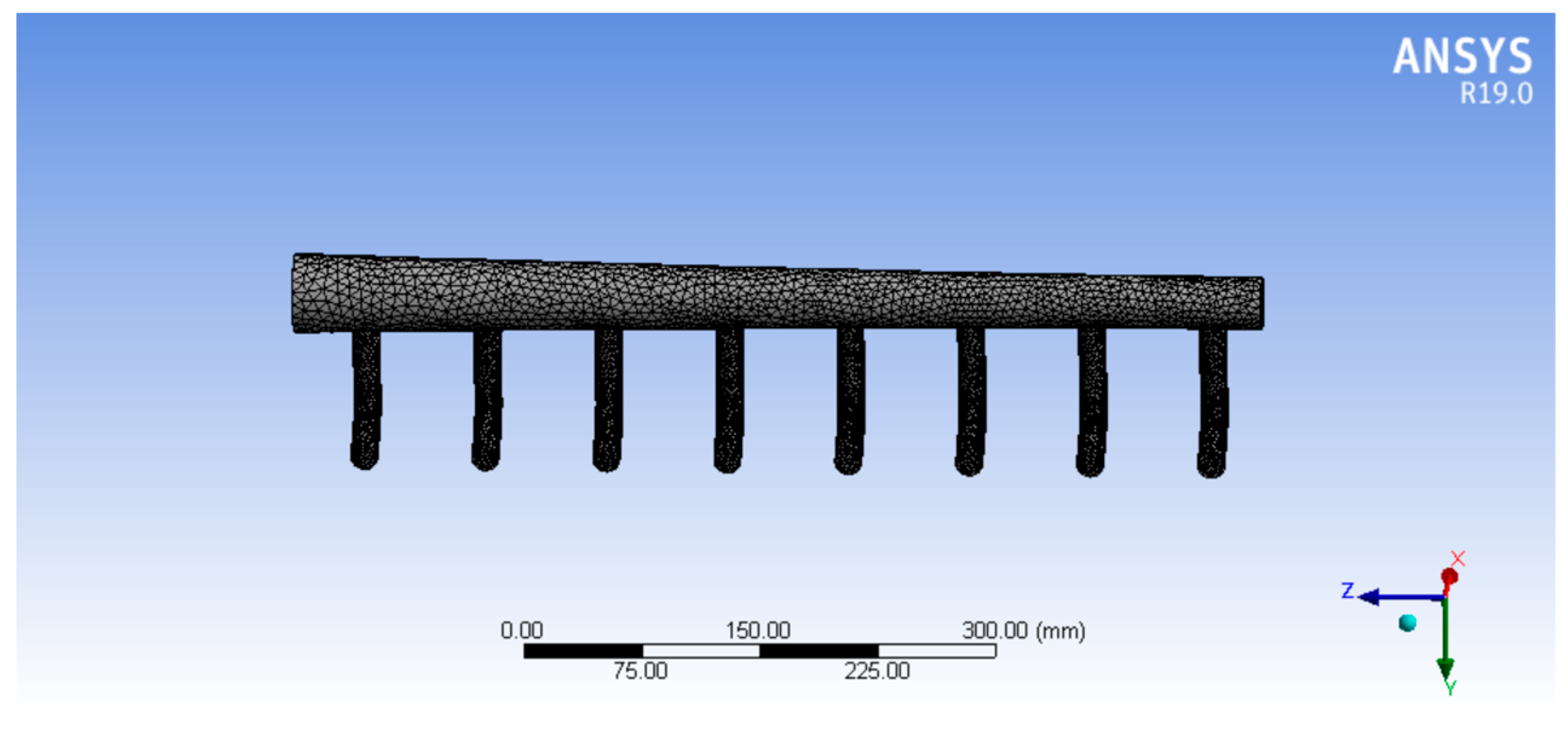
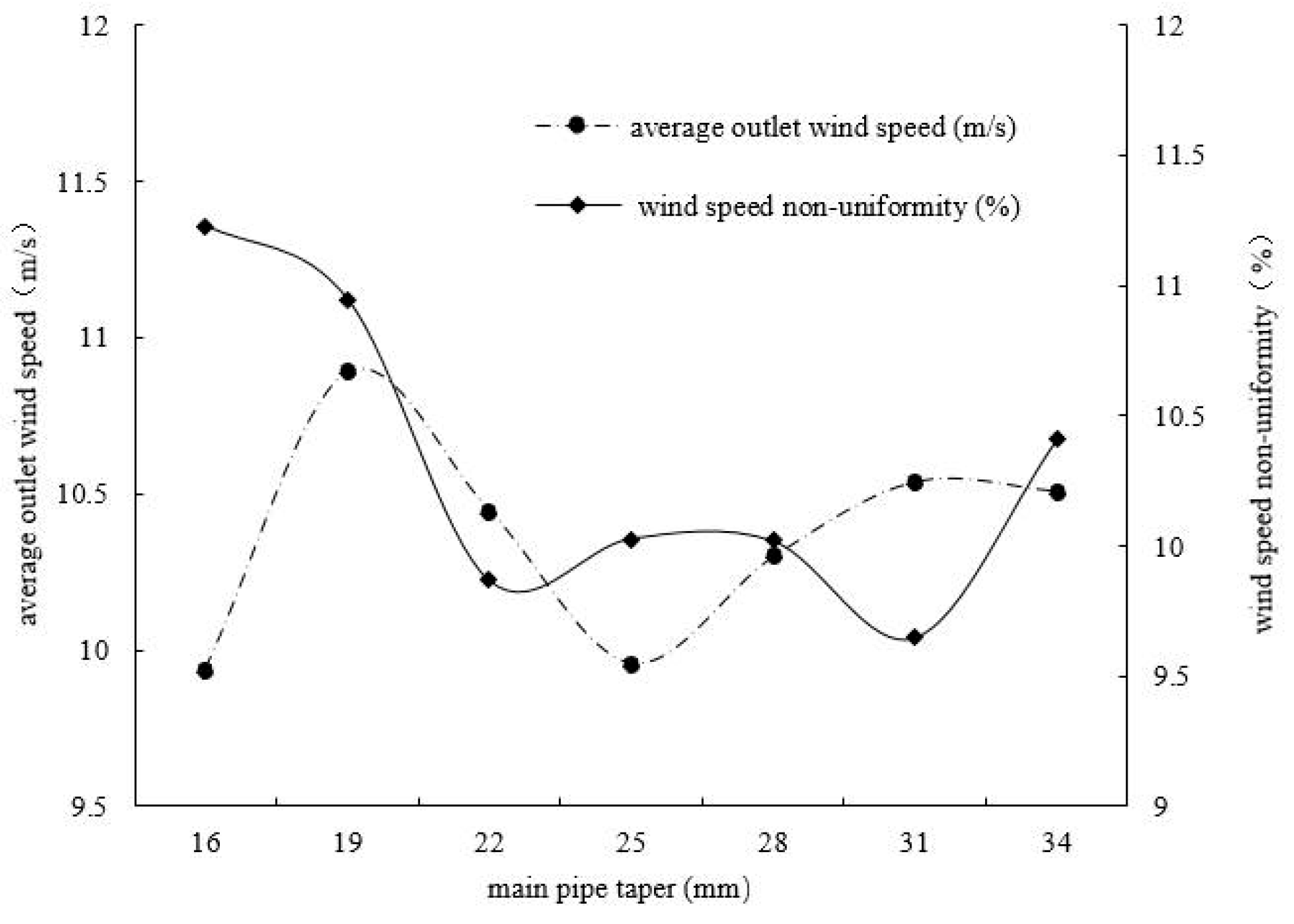
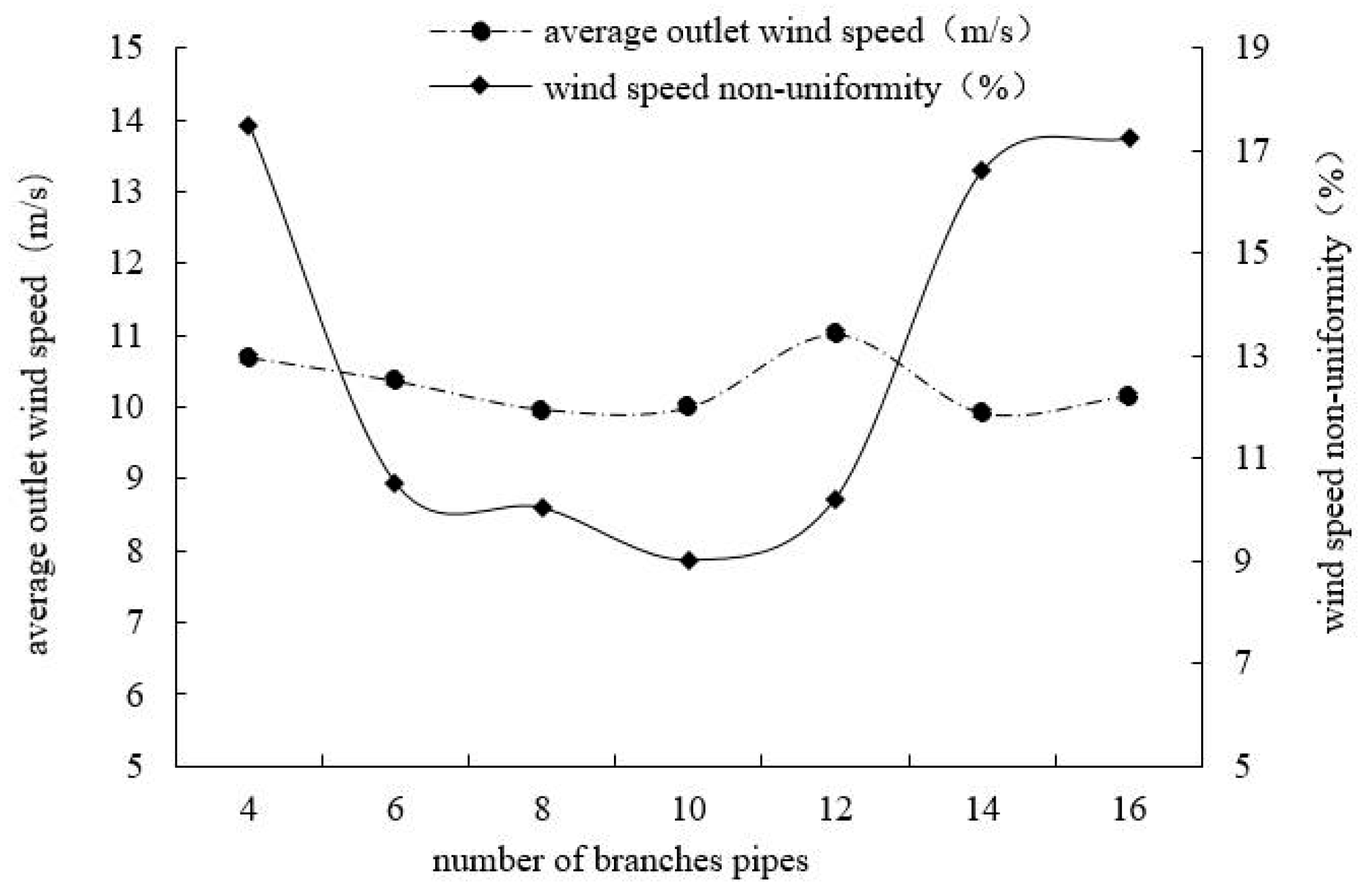


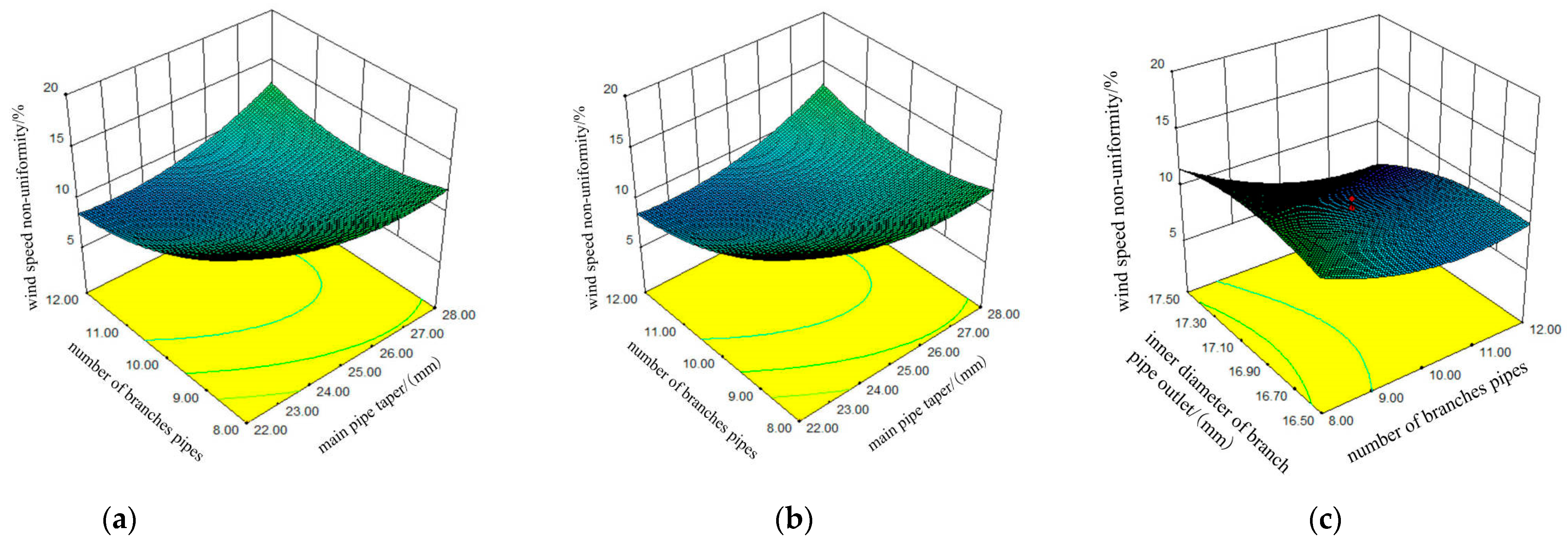




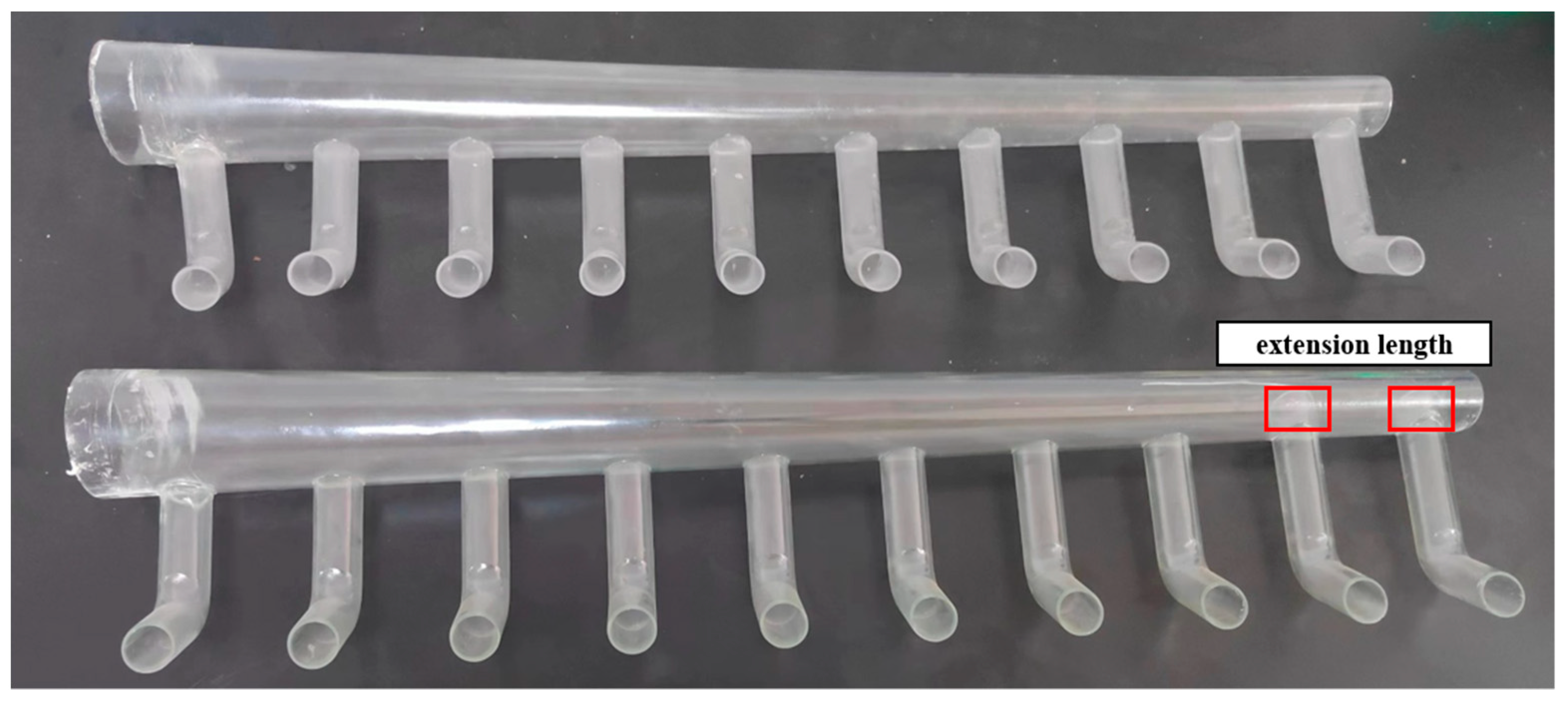

| Codes | Testing Factors | ||
|---|---|---|---|
| A (mm) | B | C (mm) | |
| −1.682 | 19 | 6 | 16 |
| −1 | 22 | 8 | 16.5 |
| 0 | 25 | 10 | 17 |
| 1 | 28 | 12 | 17.5 |
| 1.682 | 31 | 14 | 18 |
| No. | Factors | Evaluation Index | |||
|---|---|---|---|---|---|
| X1 | X2 | X3 | Y1/(m/s) | Y2/% | |
| 1 | −1 | −1 | −1 | 8.54 | 13.05 |
| 2 | 1 | −1 | −1 | 9.70 | 13.05 |
| 3 | −1 | 1 | −1 | 9.12 | 7.12 |
| 4 | 1 | 1 | −1 | 9.56 | 13.15 |
| 5 | −1 | −1 | 1 | 8.36 | 18.16 |
| 6 | 1 | −1 | 1 | 9.15 | 8.11 |
| 7 | −1 | 1 | 1 | 8.85 | 7.03 |
| 8 | 1 | 1 | 1 | 9.25 | 7.13 |
| 9 | −1.682 | 0 | 0 | 8.93 | 15.03 |
| 10 | 1.682 | 0 | 0 | 10.23 | 13.15 |
| 11 | 0 | −1.682 | 0 | 7.91 | 17.15 |
| 12 | 0 | 1.682 | 0 | 8.57 | 11.11 |
| 13 | 0 | 0 | −1.682 | 10.54 | 8.03 |
| 14 | −1 | 0 | 1.682 | 9.22 | 10.16 |
| 15 | 0 | 0 | 0 | 10.62 | 8.21 |
| 16 | 0 | 0 | 0 | 10.72 | 9.25 |
| 17 | 0 | 0 | 0 | 10.76 | 10.11 |
| 18 | 0 | 0 | 0 | 10.97 | 9.09 |
| 19 | 0 | 0 | 0 | 10.96 | 9.09 |
| 20 | 0 | 0 | 0 | 10.86 | 8.12 |
| 21 | 0 | 0 | 0 | 10.52 | 10.18 |
| 22 | 0 | 0 | 0 | 10.85 | 9.21 |
| 23 | 0 | 0 | 0 | 10.67 | 9.21 |
| Source | Sum of Squares | df | Mean Square | F-Value | p-Value |
|---|---|---|---|---|---|
| Model | 21.02 | 9 | 2.34 | 86.39 | <0.0001 ** |
| X1 | 1.79 | 1 | 1.79 | 66.30 | <0.0001 ** |
| X2 | 0.34 | 1 | 0.34 | 12.40 | 0.0038 ** |
| X3 | 0.37 | 1 | 0.37 | 13.86 | 0.0026 ** |
| X1X2 | 0.15 | 1 | 0.15 | 5.70 | 0.0329 * |
| X1X3 | 0.046 | 1 | 0.046 | 1.69 | 0.2161 |
| X2X3 | 0.002813 | 1 | 0.002813 | 0.10 | 0.7522 |
| X12 | 3.14 | 1 | 3.14 | 116.21 | <0.0001 ** |
| X22 | 13.76 | 1 | 13.76 | 509.08 | <0.0001 ** |
| X32 | 0.76 | 1 | 0.76 | 28.05 | <0.0001 ** |
| Residual | 0.35 | 13 | 0.027 | ||
| Lack of fit | 0.16 | 5 | 0.033 | 1.39 | 0.3234 |
| Pure error | 0.19 | 8 | 0.024 | ||
| Cor total | 21.37 | 22 |
| Source | Sum of Squares | df | Mean Square | F-Value | p-Value |
|---|---|---|---|---|---|
| Model | 208.28 | 9 | 23.14 | 33.09 | <0.0001 ** |
| X1 | 3.98 | 1 | 3.98 | 5.69 | 0.0330 * |
| X2 | 57.81 | 1 | 57.81 | 82.67 | <0.0001 ** |
| X3 | 9.17 | 1 | 9.17 | 13.11 | 0.0031 ** |
| X1X2 | 32.72 | 1 | 32.72 | 46.80 | 0.0001 ** |
| X1X3 | 37.93 | 1 | 37.93 | 54.24 | 0.0001 ** |
| X2X3 | 4.93 | 1 | 4.93 | 7.05 | 0.0198 * |
| X12 | 38.10 | 1 | 38.10 | 54.48 | <0.0001 ** |
| X22 | 39.73 | 1 | 39.73 | 56.81 | <0.0001 ** |
| X32 | 19.22 | 1 | 19.22 | 27.49 | 0.0002 ** |
| Residual | 9.09 | 13 | 0.70 | ||
| Lack of fit | 5.14 | 5 | 1.03 | 2.08 | 0.1702 |
| Pure error | 3.95 | 8 | 0.49 | ||
| Cor total | 217.37 | 22 |
| Number | Average Outlet Wind Speed Y1 m/s | Wind Speed Non-Uniformity Y2/% |
|---|---|---|
| 1 | 10.89 | 8.11 |
| 2 | 11.05 | 8.05 |
| 3 | 11.13 | 7.98 |
| average value | 11.02 | 8.04 |
| Number | Leakage Rate Y1/% | Bud and Leaf Integrity Rate Y2/% |
|---|---|---|
| 1 | 3.15 | 91.23 |
| 2 | 4.08 | 89.74 |
| 3 | 2.98 | 90.13 |
| average value | 3.40 | 90.36 |
Disclaimer/Publisher’s Note: The statements, opinions and data contained in all publications are solely those of the individual author(s) and contributor(s) and not of MDPI and/or the editor(s). MDPI and/or the editor(s) disclaim responsibility for any injury to people or property resulting from any ideas, methods, instructions or products referred to in the content. |
© 2024 by the authors. Licensee MDPI, Basel, Switzerland. This article is an open access article distributed under the terms and conditions of the Creative Commons Attribution (CC BY) license (https://creativecommons.org/licenses/by/4.0/).
Share and Cite
Du, Z.; Zhang, L.; Li, X.; Jin, X.; Yu, F. Optimizing Efficiency of Tea Harvester Leaf-Collection Pipeline: Numerical Simulation and Experimental Validation. Agriculture 2024, 14, 653. https://doi.org/10.3390/agriculture14050653
Du Z, Zhang L, Li X, Jin X, Yu F. Optimizing Efficiency of Tea Harvester Leaf-Collection Pipeline: Numerical Simulation and Experimental Validation. Agriculture. 2024; 14(5):653. https://doi.org/10.3390/agriculture14050653
Chicago/Turabian StyleDu, Zhe, Liyuan Zhang, Xinping Li, Xin Jin, and Fan Yu. 2024. "Optimizing Efficiency of Tea Harvester Leaf-Collection Pipeline: Numerical Simulation and Experimental Validation" Agriculture 14, no. 5: 653. https://doi.org/10.3390/agriculture14050653




